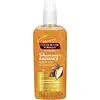What's inside
What's inside
 Key Ingredients
Key Ingredients

 Benefits
Benefits

 Concerns
Concerns

 Ingredients Side-by-side
Ingredients Side-by-side

Paraffinum Liquidum
EmollientIsopropyl Palmitate
EmollientQuaternium-90 Sepiolite
Emulsion StabilisingSesamum Indicum Seed Oil
EmollientTheobroma Cacao Extract
Skin ConditioningQuaternium-90 Montmorillonite
EmulsifyingTheobroma Cacao Seed Butter
EmollientTocopherol
AntioxidantSqualane
EmollientHelianthus Annuus Seed Oil
EmollientCalcium Titanium Borosilicate
AbrasiveTitanium Dioxide
Cosmetic ColorantIron Oxides
Tin Oxide
AbrasiveSynthetic Fluorphlogopite
BHT
AntioxidantParfum
MaskingGeraniol
PerfumingCoumarin
PerfumingCitronellol
PerfumingLinalool
PerfumingParaffinum Liquidum, Isopropyl Palmitate, Quaternium-90 Sepiolite, Sesamum Indicum Seed Oil, Theobroma Cacao Extract, Quaternium-90 Montmorillonite, Theobroma Cacao Seed Butter, Tocopherol, Squalane, Helianthus Annuus Seed Oil, Calcium Titanium Borosilicate, Titanium Dioxide, Iron Oxides, Tin Oxide, Synthetic Fluorphlogopite, BHT, Parfum, Geraniol, Coumarin, Citronellol, Linalool
Paraffinum Liquidum
EmollientIsohexadecane
EmollientEthylene/Propylene/Styrene Copolymer
PPG-14 Butyl Ether
Skin ConditioningIsopropyl Palmitate
EmollientButylene/Ethylene/Styrene Copolymer
Parfum
MaskingCalcium Sodium Borosilicate
Prunus Amygdalus Dulcis Oil
Skin ConditioningHydroxystearic Acid
CleansingCalcium Aluminum Borosilicate
Silica
AbrasiveBenzyl Alcohol
PerfumingBenzyl Salicylate
PerfumingCoumarin
PerfumingHexyl Cinnamal
PerfumingLimonene
PerfumingLinalool
PerfumingCI 77891
Cosmetic ColorantCI 77499
Cosmetic ColorantCI 77491
Cosmetic ColorantMica
Cosmetic ColorantParaffinum Liquidum, Isohexadecane, Ethylene/Propylene/Styrene Copolymer, PPG-14 Butyl Ether, Isopropyl Palmitate, Butylene/Ethylene/Styrene Copolymer, Parfum, Calcium Sodium Borosilicate, Prunus Amygdalus Dulcis Oil, Hydroxystearic Acid, Calcium Aluminum Borosilicate, Silica, Benzyl Alcohol, Benzyl Salicylate, Coumarin, Hexyl Cinnamal, Limonene, Linalool, CI 77891, CI 77499, CI 77491, Mica
Ingredients Explained
These ingredients are found in both products.
Ingredients higher up in an ingredient list are typically present in a larger amount.
Coumarins are a group of substances found naturally in plants. There are over 1300 types of coumarins identified. It has a natural vanilla scent.
Coumarin is an identified EU known allergy, meaning it may cause an allergic reaction when applied to the skin.
In many countries, coumarin is banned as a food additive. However, it can be found in soaps, tobacco products, and some alcohol drinks.
Plants use coumarins as a chemical defense. Some plants that have coumarins include lavender, tonka beans, and yellow clovers.
Learn more about CoumarinIsopropyl Palmitate is a texture enhancer and emollient. It is an ester of isopropyl alcohol and palmitic acid.
Palmitates are emollients. Emollients help keep your skin soft and smooth by creating a barrier that traps moisture in.
When added to cosmetics, Isopropyl Palmitate creates a silky texture and improves spreadability.
Isopropyl Palmitate may not be fungal acne safe. It can worsen acne prone skin.
Learn more about Isopropyl PalmitateLinalool is a fragrance and helps add scent to products. It's derived from common plants such as cinnamon, mint, citrus, and lavender.
Like Limonene, this ingredient oxidizes when exposed to air. Oxidized linalool can cause allergies and skin sensitivity.
This ingredient has a scent that is floral, spicy tropical, and citrus-like.
Learn more about LinaloolParaffinum Liquidum is also known as liquid paraffin. It is a type of highly refined mineral oil.
Like other oils, Paraffinum Liquidum has emollient properties. Emollients help soothe and soften the skin. By creating a barrier to trap moisture within, emollients help keep your skin hydrated.
Paraffinum Liquidum does not irritate the skin and is non-comedogenic.
Learn more about Paraffinum LiquidumParfum is a catch-all term for an ingredient or more that is used to give a scent to products.
Also called "fragrance", this ingredient can be a blend of hundreds of chemicals or plant oils. This means every product with "fragrance" or "parfum" in the ingredients list is a different mixture.
For instance, Habanolide is a proprietary trade name for a specific aroma chemical. When used as a fragrance ingredient in cosmetics, most aroma chemicals fall under the broad labeling category of “FRAGRANCE” or “PARFUM” according to EU and US regulations.
The term 'parfum' or 'fragrance' is not regulated in many countries. In many cases, it is up to the brand to define this term.
For instance, many brands choose to label themselves as "fragrance-free" because they are not using synthetic fragrances. However, their products may still contain ingredients such as essential oils that are considered a fragrance by INCI standards.
One example is Calendula flower extract. Calendula is an essential oil that still imparts a scent or 'fragrance'.
Depending on the blend, the ingredients in the mixture can cause allergies and sensitivities on the skin. Some ingredients that are known EU allergens include linalool and citronellol.
Parfum can also be used to mask or cover an unpleasant scent.
The bottom line is: not all fragrances/parfum/ingredients are created equally. If you are worried about fragrances, we recommend taking a closer look at an ingredient. And of course, we always recommend speaking with a professional.
Learn more about Parfum